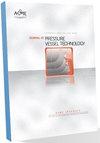Designing Cladded Components for High Temperature Nuclear Service. Part-2: Design Rules
IF 1
4区 工程技术
Q4 ENGINEERING, MECHANICAL
Journal of Pressure Vessel Technology-Transactions of the Asme
Pub Date : 2022-11-08
DOI:10.1115/1.4056151
引用次数: 0
Abstract
The challenge of using existing ASME Section III, Division 5, Class A metallic materials for the construction of structural components of advanced reactors with corrosive coolants could be mitigated by allowing designers to use cladding to protect the base materials from corrosion. However, the existing Section III, Division 5 rules provide no guidance on the evaluation of strain accumulation and creep-fatigue damage in cladded components. The availability of design rules for cladded components that do not require long-term clad materials testing could promote the application of the cladding approach to accelerate the deployment schedule of these advanced reactor systems. To avoid long-term properties for the clad materials Part 1 of this work proposes two approximate design analysis methods for two types of clad materials - soft clads that creep much faster and have lower yield stress than the Class A base material, and hard clads that creep much slower and have higher yield stress than the Class A base material. The proposed analysis methods approximate the response of a soft clad by treating it as perfectly compliant and of a hard clad by treating it as linear elastic. Based on these approximate design analysis strategies this Part 2 develops a complete set of design rules for Class A components cladded with either soft or hard clad materials. Part 2 discusses the reasoning behind the proposed design rules and uses example finite element analyses of representative reactor components to illustrate the use of these design methods.高温核设施用包壳部件的设计。第2部分:设计规则
使用现有的ASME第III节,第5部分,A类金属材料来建造具有腐蚀性冷却剂的先进反应堆的结构部件的挑战可以通过允许设计师使用包层来保护基础材料免受腐蚀来缓解。然而,现有的Section III, Division 5规则没有对包覆构件的应变积累和蠕变疲劳损伤的评估提供指导。不需要长期包层材料测试的包层组件设计规则的可用性可以促进包层方法的应用,从而加快这些先进反应堆系统的部署进度。为了避免复合材料的长期性能,本工作的第1部分提出了两种近似设计分析方法,用于两种类型的复合材料-软包层,其蠕变速度快得多,屈服应力比A类基材低,硬包层,蠕变速度慢得多,屈服应力比A类基材高。所提出的分析方法将软包层的响应近似为完全柔顺,将硬包层的响应近似为线弹性。基于这些近似的设计分析策略,本部分开发了一套完整的a类组件的设计规则,无论是软包覆材料还是硬包覆材料。第2部分讨论了所建议的设计规则背后的原因,并使用代表性反应堆部件的示例有限元分析来说明这些设计方法的使用。
本文章由计算机程序翻译,如有差异,请以英文原文为准。
求助全文
约1分钟内获得全文
求助全文
来源期刊
CiteScore
2.10
自引率
10.00%
发文量
77
审稿时长
4.2 months
期刊介绍:
The Journal of Pressure Vessel Technology is the premier publication for the highest-quality research and interpretive reports on the design, analysis, materials, fabrication, construction, inspection, operation, and failure prevention of pressure vessels, piping, pipelines, power and heating boilers, heat exchangers, reaction vessels, pumps, valves, and other pressure and temperature-bearing components, as well as the nondestructive evaluation of critical components in mechanical engineering applications. Not only does the Journal cover all topics dealing with the design and analysis of pressure vessels, piping, and components, but it also contains discussions of their related codes and standards.
Applicable pressure technology areas of interest include: Dynamic and seismic analysis; Equipment qualification; Fabrication; Welding processes and integrity; Operation of vessels and piping; Fatigue and fracture prediction; Finite and boundary element methods; Fluid-structure interaction; High pressure engineering; Elevated temperature analysis and design; Inelastic analysis; Life extension; Lifeline earthquake engineering; PVP materials and their property databases; NDE; safety and reliability; Verification and qualification of software.

 求助内容:
求助内容: 应助结果提醒方式:
应助结果提醒方式:


